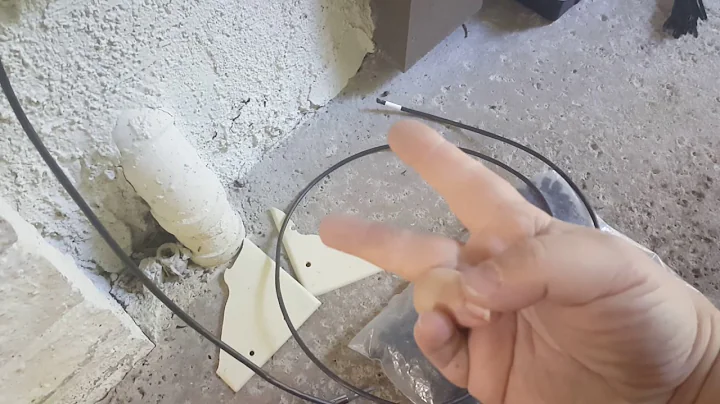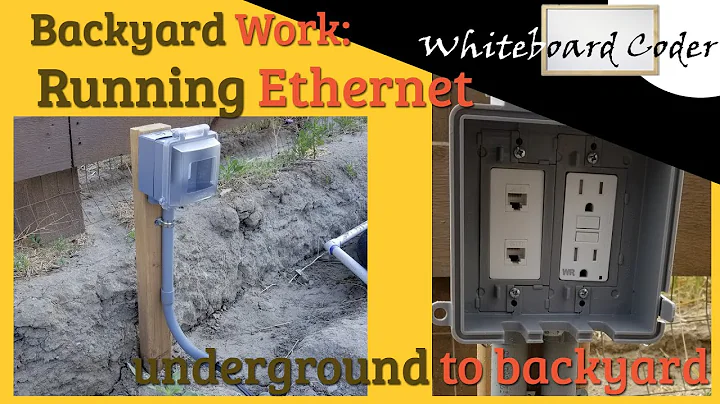Running CAT 5 cable outdoors
Solution 1
Yes. This article answers most of your questions.
Is there special outdoor-rated cat5e/cat6 I should use?
"Preferably, special exterior or direct burial CAT5 cables should be used for outdoor runs instead of ordinary CAT5."
If put it in a dug trench, do I need to put it in conduit?
"Exterior-grade Ethernet cables are waterproof and thus do not require conduit."
If I run parallel to electric, how much separation do I need, and do I go UTP or STP?
"5-20cm (6-8 inches) and at least that far away from power lines or other sources of electrical interference."
If I do an overhead run, how should I properly ground it against lightning?
"Accordingly, CAT5 surge protectors should be installed as part of outdoor Ethernet networks to guard against lightning strikes."
Solution 2
I did the same with conduit. This way you can run regular wire inside and if you ever need to run additional wires you just feed another one through. I did this for my securtiy system and added the Cat 5 later, I am not sure that I wouldn't have just used wireless had I not already put the conduit in there.
Edit: Just a minor detail, at least minor until you need it. When you run the conduit be sure to pull a string through and tie it off at both ends. You will use that to pull any additional wires through if you need to later. Thanks to Chris Noe for pointing out my omission.
Solution 3
Won't write up a full article as others seem to have done a lot better than I could... however...
No matter the temptation to save money and use standard cable - DON'T!
A few years ago, I had to go to a school that had used standard cat5 cable all over the place and across flat roofs to go building to building.
They called me in after a lightning strike killed EVERY rj45 port on switches, routers, servers, desktops... and even fried IP cameras and print servers - Everything you can imagine!
Changing over 300 NIC's was a very long job and it was expensive to replace the other network equipment.
They are now using fibre optic... Not that much of a practical solution for home networking if you already have equipment, but certainly go proper - conduit, trench e.t.c.
(or if you do go cheap, remember my contact details for the future in case you have a big job coming!!)
Solution 4
I'd use conduit for ease of maintenance. If a cable goes bad, you can pull new cable though the conduit with out having to dig up and rebury the cable. I would still use an exterior rated cable.
Solution 5
However tempted you are to run Cat5 or Cat6 between buildings, DON'T.
Apart from the issues of lightning strikes and proximity to power cables causing interference, you can get surprisingly high differences in local earth potential due to varying soil/ground conductivity
Whilst equipment will probably handle the voltages involved, the poor schmuck who happens to put his hand on the plug won't. This may not happen for years - if ever. but it's a risk worth avoiding. Yes, there are supposed to be isolation transformers in the transceivers. Don't rely on them being there or being rated appropriately.
In addition, copper cables buried in the ground (or run overhead) will eventually suffer water ingress and corrode. Fiber-optic is immune to this failure mode.
Outdoor fiber-optic cable is cheaper than you might think, as are media converters.
Never direct-bury, for the reasons already elaborated in other posts.
It is worth putting a tracer wire in the duct as this makes it a lot easier to use cable location kit later on (eg, CAT4 and Genny). This can be anything as long as it's conductive and corrosion-resistant (unconnected at either end). You can trace a non-conductive fiber but it's a lot harder as the coupled signal is almost non-existant - personal experience having to trace a 1000m telco fiber run that had been laid 25 years previously with inadequate documentation.
I've seen people kill 2 birds with one stone on this front by using electric fence string as the draw wire. Personally I wouldn't recommend it.
The old "Do it right or do it over" cliche comes into play here. Labour costs outweigh the materials, so skimping out is simply uneconomic, long-term.
Related videos on Youtube
yoyoyoyosef
Updated on September 17, 2022Comments
-
yoyoyoyosef over 1 year
I'm trying to extend my network to an unconnected garage that's about 20 yards away from my house. What's the best way to do this?
- Is there special outdoor-rated CAT5e/CAT6 I should use?
- If put it in a dug trench, do I need to put it in conduit?
- If I run parallel to electric, how much separation do I need, and do I go UTP or STP?
- If I do an overhead run, how should I properly ground it against lightning?
-
yoyoyoyosef over 14 yearsThanks for all the answers so far, they're very helpful. Does anyone have advice re: UTP vs STP if I'm going to run parallel to electric with 6" separation?
-
Daniel R Hicks almost 11 yearsAccording to code you need to have lightning arresters even if run underground. And this isn't a case of "overreaching" on the part of the code guys -- lightning can and does strike underground cables.
-
 Admin almost 11 yearsIf you dig do yourself and perhaps your neighbor a favor by contacting a utility marking agency. I live in Virginia and it is offered free through a state agency so you might want to start there. I ran STP using grey PVC (pretty cheap from Lowes) from my home to my shed and cut a Verizon analog phone line. While I have no idea who would even know the analog line was gone to begin with I got fined $150.00 and had to pay Verizon $250.00. An expensive lesson learned for sure.
Admin almost 11 yearsIf you dig do yourself and perhaps your neighbor a favor by contacting a utility marking agency. I live in Virginia and it is offered free through a state agency so you might want to start there. I ran STP using grey PVC (pretty cheap from Lowes) from my home to my shed and cut a Verizon analog phone line. While I have no idea who would even know the analog line was gone to begin with I got fined $150.00 and had to pay Verizon $250.00. An expensive lesson learned for sure. -
 Axel Kemper almost 11 yearsMake sure that both buildings are properly grounded electrically. A voltage difference of some millivolts causes compensation currents across the shield of your STP which might burn the cable and ruin your devices. A fiber optic connection or galvanic isolation would exclude such risks.
Axel Kemper almost 11 yearsMake sure that both buildings are properly grounded electrically. A voltage difference of some millivolts causes compensation currents across the shield of your STP which might burn the cable and ruin your devices. A fiber optic connection or galvanic isolation would exclude such risks.
-
Chris Noe over 14 yearsPulling string through your conduit can greatly aid such future expansion.
-
Keck over 14 yearsIn my experience, it doesn't hurt to combine both trenched conduit and direct burial wire. Expansion is great. Direct burial alone tends to get eaten rather easily if you have any sort of rat/mole/gopher digging around. Straight conduit can leak if done improperly, but the combo is a reliable combo. If you're concerned about dealing with conduit, flexible "liquid-tight" grey pvc tubing is "very" easy to route, but does cost a bit more than standard pvc.
-
msanford over 14 years@Keck +1 for conduit. All wires are waterproof because they're sheathed in rubber, but you'll (hopefully) never see your telco or municipality running bare wires underground.
-
Jim C over 14 yearsI doubt even exterior grade cable buried in a conduit will survive a lighting strike. However I shudder at the thought of cable laid across roof tops exposed to the elements.
-
William Hilsum over 14 yearsI couldn't believe it, but if you take a look at many modern schools, they all do it now - just usually in conduit, thick rubber around the cables, or use fibre optic - however, again, many do it - it really depends on the layout of the building though.
-
Dan Pritts about 9 yearson the other hand, if you ask about the building code, you are almost guaranteed to get inspected.




